The luminous, hot star known as Wolf-Rayet 124 (WR 124)
IMAGE: NASA, ESA, CSA, STScI, Webb ERO Production Team
About 15,000 light years away, a star is getting ready to go supernova. The James Webb Space Telescope (JWST) has captured a beautiful image of a massive star, known as a Wolf-Rayet star, that has begun to shed its outer layers before exploding in a supernova.
This star is called WR 124, and it is about 30 times as massive as the sun. When stars that huge run out of hydrogen to burn in their core, they begin to fuse heavier elements instead. This fusion creates powerful blasts of energy, blowing out gusts of wind at velocities in the millions of kilometres per hour.
The powerful winds strip away the outer layers of the star, resulting in a huge cloud of dust and gas like the one revealed by this JWST image. Researchers calculated that WR 124 has already lost about 10 times the mass of the sun.
Advertisment
Once the star runs out of heavy elements it can fuse, it will explode. The Wolf-Rayet phase of a massive star’s lifetime is relatively short, a few million years at most, before the star blows up.
The dust the star produces during that time could be cosmically important, though. The detail in the JWST observations should help astronomers figure out exactly how this dust behaves and whether the dust grains are large and plentiful enough to survive the looming supernova.
That’s important not only because of the role dust plays in the evolution of the universe, forming the environment where cosmic building blocks grow, but also because researchers think there is far more dust in the universe than our best theories for dust formation can explain. Determining how dust behaves around Wolf-Rayet stars like WR 124 could help us figure out where all that extra dust came from.
Topics:

